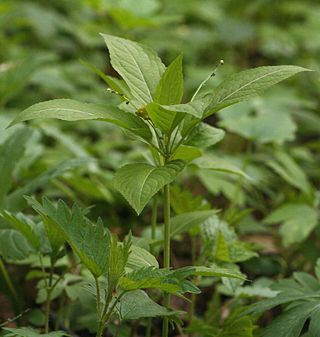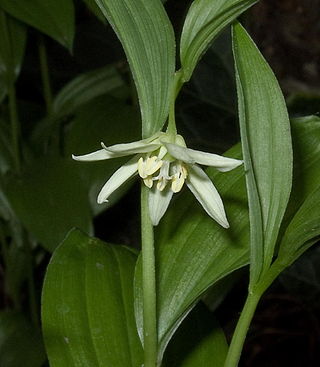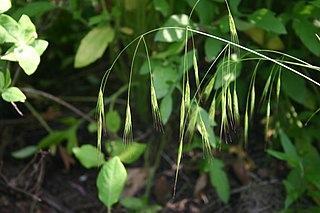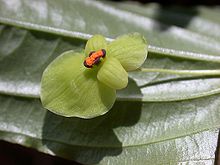
John Torrey was an American botanist, chemist, and physician. Throughout much of his career, he was a teacher of chemistry, often at multiple universities, while he also pursued botanical work, focusing on the flora of North America. His most renowned works include studies of the New York flora, the Mexican Boundary, the Pacific railroad surveys, and the uncompleted Flora of North America.

The Chenopodioideae are a subfamily of the flowering plant family Amaranthaceae in the APG III system, which is largely based on molecular phylogeny, but were included – together with other subfamilies – in the family Chenopodiaceae, or goosefoot family, in the Cronquist system.

Mercurialis is a genus of plants in the family Euphorbiaceae, the spurges, known commonly as the mercuries. These are slender herbs (forbs), rhizomatious perennials and woody perennials, native to Europe, North Africa, and Asia.
- Mercurialis annuaL. – most of Europe, North Africa, the Middle East, and islands of the eastern Atlantic
- Mercurialis canariensisObbard & S.A.Harris – Canary Islands
- Mercurialis corsicaCoss. & Kralik – Corsica, Sardinia
- Mercurialis ellipticaLam. – Spain, Portugal, Morocco
- Mercurialis huetiiHanry – Spain, France, Morocco
- Mercurialis leiocarpaSiebold & Zucc. – China, Japan, Korea, Ryukyu Islands, Thailand, Assam, Bhutan, Nepal
- Mercurialis × longifoliaLam. – Spain, Portugal, France (M. annua × M. tomentosa)
- Mercurialis ovataSternb. & Hoppe – C + E Europe and SW Asia from Germany + Italy to Russia + Syria
- Mercurialis × paxiiGraebn. – C + E Europe from Germany to Crimea (M. ovata × M. perennis)
- Mercurialis perennisL. – most of Europe plus Algeria, Caucasus, Turkey, Iran
- Mercurialis reverchoniiRouy – Spain, Morocco
- Mercurialis tomentosaL. – Spain, Portugal, France, Balearic Islands

The Cimicifugeae are a tribe of flowering plants belonging to the family Ranunculaceae, based on the now obsolete genus Cimicifuga. The name Cimicifuga means "bed bug repeller".

Tiarella, the foamflowers, is a genus of flowering plants in the family Saxifragaceae. The generic name Tiarella means "little turban", which suggests the shape of the seed capsules. Worldwide there are seven species, one each in eastern Asia and western North America, plus five species in eastern North America. As of October 2022, the taxonomy of Tiarella in eastern North America is in flux.

Disporum is a genus of about 20 species of perennial flowering plants, found in Asia from northern India to Japan, south to Indonesia and north into the Russian Far East.

Isocoma, commonly called jimmyweed or goldenweed, is a genus of North American semi-woody shrubs in the family Asteraceae. It is found in the semi-arid areas of Southwestern United States and Mexico.

Helianthella, the little sunflower, is a genus of North American plants in the family Asteraceae.

Hulsea is a small genus of North American flowering plants in the family Asteraceae known commonly as alpinegold.

Geraea is a genus of the family Asteraceae from the southwestern United States and northwestern Mexico, commonly called the desert sunflower.

Crepis runcinata is a North American species of flowering plant in the family Asteraceae known by the common name fiddleleaf hawksbeard. It is native to western and central Canada, the western and central United States and northern Mexico (Chihuahua).

Bradburia is a North American genus of flowering plants in the family Asteraceae, native to the southern United States.

Schizachne is a genus of Eurasian and North American plants in the grass family. The only accepted species is Schizachne purpurascens, commonly called false melic. Three subspecies are recognized:

Nabalus is a genus of Asian and North American flowering plants in the tribe Cichorieae within the family Asteraceae.

Solidago houghtonii is a rare North American species of flowering plant in the family Asteraceae known as Houghton's goldenrod. It is native to southern Ontario, Canada and the northern United States. It is threatened by the loss and degradation of its habitat. It is a federally listed threatened species of the United States and it is designated a species of special concern by Canada's Committee on the Status of Endangered Wildlife in Canada.

Baccharis salicina is a species of plant in the family Asteraceae. Common names include willow baccharis, and Great Plains false willow. It is a shrub found in North America where it grows in mildly saline areas.
Croomia pauciflora is a plant species native to Florida, Alabama, Georgia and Louisiana. Croomia pauciflora is generally found in rich loams in forests.
Aphanostephus riddellii is a North American species of flowering plants in the family Asteraceae, with the common name Riddell's lazydaisy. It is native to the southwestern and south-central United States, as well as to the state of Coahuila in northern Mexico.
Bradburia hirtella is a North American species of flowering plants in the family Asteraceae, native to Texas and Louisiana in the south-central United States.

Eucephalus elegans is a North American species of flowering plants in the family Asteraceae known by the common name elegant aster. It is native to the western United States, largely the Great Basin, in the states of Colorado, Idaho, Montana, Nevada, Oregon, Utah, Wyoming.

















